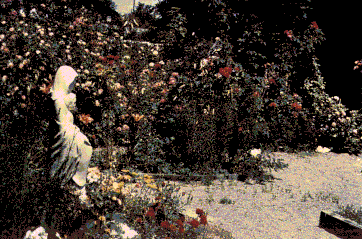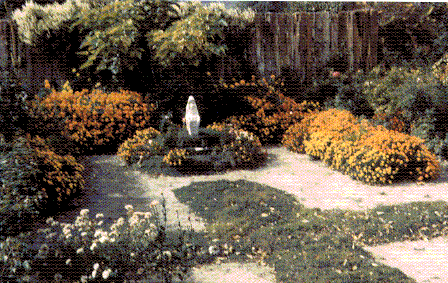John Stokes and Mary's Gardens
A Garden Full of Aves
– John S. Stokes Jr., The Marianist, April, 1962
In a former era, the now almost legendary Johnny Appleseed traveled through the pioneer communities of Eastern Pennsylvania and Ohio sowing apple orchards for the new settlers.
Today on the ever-expanding frontier of devotion to Mary, the Mother of God, dedicated pioneers are sowing another kind of seed . . . seed for "Mary Gardens" of symbolical "Flowers of Our Lady."
One such ardent gardener is Bonnie Roberson of Hagerman, Idaho, who found, in tending her own Mary Garden and in helping to start others, a way of uniting her love of gardening with her devotion to Mary.

For a number of years before she learned of the Mary Garden idea, Mrs. Roberson, with the assistance of her husband, had grown a garden of herbs as a hobby and as a means of income. Being especially interested in the traditional lore of herbs, which extends back to medieval times and on back into the mists of antiquity, she had named it the "Garden of Memories."
Among the herbs in the garden, she had particular affection for those associated by legend with the life of the Holy Family. She loved to recall that sweet-smelling thyme and marjoram and tansey, all once known as "Our Lady's Bedstraw," were reputed to have been present in the straw of the manger at Bethlehem.
She would recall also that bitter and sour herbs like dandelion and sorrel traditionally were regarded as symbols of the bitterness of Our Lord's passion and Our Lady's sorrows. Fragrant roses and lilies, according to an early Christian tradition, were found in Our Lady's tomb after her assumption into heaven. The favorite - herbs, spearmint, alecost and fennel - were called Our Lady's Mint, Our Lady's Balsam and Our Lady's Fennel. Sage, because of its many beneficial qualities, was believed to have been blessed by Our Lady.
Reflection on these rich associations warmed Mrs. Roberson's heart as she worked in the garden each day. In time she came to understand that they bore witness to a profound religious truth. They were not just historical curiosities or superstitions. They were much more than this.
They testified to the intuitive discovery of medieval Christians that, of all God's creatures, none could surpass fragrant herbs and flowers in suggesting and recalling our Lady's spiritual sweetness: soothing and healing herbs in suggesting her heavenly mercy and succor; or bitter and sour herbs in suggesting her bitter sorrows.
Steeped in the religious symbolism of herbs, Mrs. Roberson learned through the National Catholic Rural Life Conference of a project, Mary's Gardens, in Philadelphia, dedicated to restoring the custom of growing an entire Mary Garden of plants associated with Our Lady.
Through literature obtained from this organization, she learned that, besides herbs, there were a large number of garden and wild flowers whose characteristic forms and colors and seasons had been adopted in medieval times as reminders of Mary's virtues and mysteries.
It became evident to Mrs. Roberson that flowers are unexcelled in suggesting for our meditation the immaculateness of Mary's purity, the beauty of her holiness, and the splendor of her heavenly glory.
In a flash Mrs. Roberson saw that a Mary Garden would not be a garden of memories of the past but a work of prayer and devotion in the present and continuing into the future. Such a wealth of plant and flower symbols would help keep the fullness of Our Lady's virtues and mysteries in mind for prayer and meditation during garden work. They would also be a constant reminder to offer the joys and sacrifices of the work for spiritual intentions.
Happily there was an unused area in her yard in which she could plant a Mary Garden around a statue of the Virgin and Child. Entirely separate from the Garden of Memories, the Mary Garden would be undertaken as a work of veneration and prayer to Our Lady, and nothing in it would be offered for sale. Flowers would be picked from the garden only for church, for adornment of Our Lady's statues, or for the sick.
In the spring and summer Mrs. Roberson sowed seeds and rooted cuttings of Our Lady's biennial and perennial flowers in nursery beds. In the fall she laid out and dug the Mary Garden in the form of a cross with a surrounding rectangular border, and planted bulbs of Our Lady's Flowers.
 Spring
Spring
Early the following spring she started seeds of Marian annual flowers indoors at a sunny window. Then, when the weather warmed up, she moved the plants and seedlings from the nursery beds and seed boxes and planted them in the garden according to the plan she had drawn in the fall.
Now at last, after a year of anticipation, the Mary Garden was a reality. Mrs Roberson plunged into the work of watering it and cultivating it with joy, giving loving care to each plant. Just the sight or thought of the Mary Garden gave new meaning to her work in the Garden of Memories as well, and, in fact, to her housework and to her entire day.
As customers came to pick out plants from the Garden of Memories, or as neighbors came to call, she would take them for a visit to the Mary Garden, showing them the symbolism of the plants and flowers. From the religious meaning of the plants, their arrangement around the central statue of the Virgin and Child, and their careful cultivation, visitors immediately sensed this was a very special kind of garden, a garden of peace and prayer and love, a garden with a fullness of meaning and beauty not to be found in the usual herb or flower garden.
Soon strangers began to make visits especially to see the Mary Garden. Letters asking for information started coming in from those who lived too far away to make a visit.
At home Mrs. Roberson found that her twenty-months-old granddaughter, Juanita Marie, adopted the Mary Garden as her favorite outdoor spot. She loved to run over to kiss "the Baby first and then the Mama" each time she entered it. Neighboring children of preschool age seemed to take more interest in the story of Mary and Jesus as told by the plants of the Mary Garden than from their religious picture books.
 Summer
Summer
As soon as Mrs. Roberson noted the very real interest in the Mary Garden from adults and children, gardeners and non-gardeners, and people of all faiths, she started additional seeds and cuttings of Our Lady's Flowers as a surplus from which to help others start Mary Gardens of their own.
She also began accepting invitations to speak on the Mary Garden idea before garden clubs and religious groups. By fall, a garden club from Boise, one hundred miles away, had chartered a bus to make a special trip to visit the garden.
Realizing that others were not as readily able as she to start a Mary Garden, she conceived a plan. Each year she would help start several Mary Gardens at religious institutions by providing plants as a gift and then personally joining in the actual work of planning, digging, and planting the gardens. With the progress of the seasons she would return from time to time to give further gardening instructions and also to share her concept of the prayerful meaning of the garden and the work of caring for it.
 Fall
Fall
The following spring she was able to assist in starting three gardens. This year she is helping with two more Mary Gardens: one at Mercy Academy in Buhl, and the other an adjunct to the famous Our Lady's Garden Rosary, laid out in the form of giant rosary beads surrounded by rose bushes, at the Holy Family Convent of the Missionary Sisters of St. Benedict, Benet Lake, Wisconsin. For this last garden she has prepared a detailed planting plan.
To families who wish to start Mary Gardens around their backyard Mary Shrines, she explains how a Mary Garden can be built up gradually over several years by using those Flowers of Our Lady already commonly grown in home flower gardens in the region and requiring no special gardening knowledge. Such plants provide a tried and true foundation for a Mary Garden which even beginning gardeners can plant with confidence.
To those who already have gardens or flower beds, she explains which of their flowers are especially associated with Our Lady and suggests that they learn to know them and to think of them according to these associations, which have come down to us through the ages.
Mrs. Roberson's Mary Garden work has also received recognition among established horticulturalists. An article on her garden appeared in a recent issue of The Herb Grower magazine, together with articles on Synagogue Gardens and Bible Gardens, and she has been asked to exhibit a miniature replica of her Mary Garden at the annual meeting of the Herb Society of America in Washington, D.C., this month.
With this solid beginning, Mrs. Roberson hopes to see more and more Mary Gardens established locally and nationally. Through her reading and research she has made substantial contributions to the library and files of the international Mary Garden center in Philadelphia.
She envisages the rich community of Christian friendship and sociability which can be developed everywhere through garden visits and through the exchange of seeds, plants, and gardening information.
Hopefully Mrs. Roberson's example will inspire many others to become Mary-Gardeners, and perhaps, like her, to become Mary-Garden Missionaries themselves.
Reprinted with permission
See "Mary Gardener of Love"
The John Stokes and Mary's Garden collection was transferred to the Marian Library in May 2013. In addition to his archives, manuscripts, artwork, and personal library, John S. Stokes also donated his extensive website. It was transferred to the Marian Library in early 2010. This particular entry is archived content original to Stokes' Mary's Gardens website. It is possible that some text, hyperlinks, etc. are outdated.